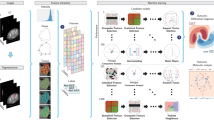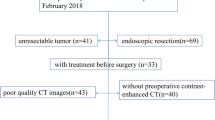Abstract
Purpose
Our primary purpose was to search for computed tomography (CT) radiomic features of gastrointestinal stromal tumors (GISTs) that could potentially correlate with the risk class according to the Miettinen classification. Subsequently, assess the existence of features with possible predictive value in differentiating responder from non-responder patients to first-line therapy with Imatinib.
Methods
A retrospective study design was carried out using data from June 2009 to December 2020. We analyzed all the preoperative CTs of patients undergoing surgery for GISTs. We segmented non-contrast-enhanced CT (NCECT) and contrast-enhanced venous CT (CECT) images obtained either on three different CT scans (heterogeneous cohort) or on a single CT scan (homogeneous cohort). We then divided the patients into two groups according to Miettinen classification criteria and based on the predictive value of response to first-line therapy with Imatinib.
Results
We examined 54 patients with pathological confirmation of GISTs. For the heterogeneous cohort, we found a statistically significant relationship between 57 radiomic features for NCECT and 56 radiomic features for CECT using the Miettinen risk classification. In the homogeneous cohort, we found the same relationship between 8 features for the NCECT and 5 features for CECT, all included in the heterogeneous cohort. The various radiomic features are distributed with different values in the two risk stratification groups according to the Miettinen classification. We also found some features for groups predictive of response to first-line therapy with Imatinib.
Conclusions
We found radiomic features that correlate with statistical significance for both the Miettinen risk classification and the molecular subtypes of response. All features found in the homogeneous study cohort were also found in the heterogeneous cohort. CT radiomic features may be useful in assessing the risk class and prognosis of GISTs.









Similar content being viewed by others
References
Zhang L, Kang L, Li G et al (2020) Computed tomography-based radiomics model for discriminating the risk stratification of gastrointestinal stromal tumors. Radiol Medica 125(5):465–473. https://doi.org/10.1007/s11547-020-01138-6
Corless CL, Ballman KV, Antonescu CR et al (2014) Pathologic and molecular features correlate with long-term outcome after adjuvant therapy of resected primary GI stromal tumor: the ACOSOG Z9001 trial. J Clin Oncol 32(15):1563–1570. https://doi.org/10.1200/JCO.2013.51.2046
Sircar K, Hewlett BR, Huizinga JD, Chorneyko K, Berezin I, Riddell RH (1999) Interstitial cells of Cajal as precursors of gastrointestinal stromal tumors. Am J Surg Pathol 23(4):377–389. https://doi.org/10.1097/00000478-199904000-00002
Kindblom LG, Remotti HE, Aldenborg F, Meis-Kindblom JM (1998) Gastrointestinal pacemaker cell tumor (GIPACT): gastrointestinal stromal tumors show phenotypic characteristics of the interstitial cells of Cajal. Am J Pathol 152(5):1259–1269
Dei S, Molli T, Alessandro C, Grignani G, Oncologia SC, Città ASL (2020) Linee guida SARCOMI DEI TESSUTI MOLLI E GIST In collaborazione con. Published online 2020. https://www.aiom.it/wp-content/uploads/2020/10/2020_LG_AIOM_Sarcomi.pdf
Matthews BD, Joels CS, Kercher KW, Heniford BT (2004) Gastrointestinal stromal tumors of the stomach. Minerva Chir 59(3):219–231. https://doi.org/10.1097/01.pas.0000146010.92933.de
Miettinen M, Lasota J (2006) Gastrointestinal stromal tumors: pathology and prognosis at different sites. Semin Diagn Pathol 23(2):70–83. https://doi.org/10.1053/j.semdp.2006.09.001
Casali PG, Abecassis N, Bauer S et al (2018) Gastrointestinal stromal tumours: ESMO-EURACAN clinical practice guidelines for diagnosis, treatment and follow-up. Ann Oncol. https://doi.org/10.1093/annonc/mdy095
Rossi S, Miceli R, Messerini L et al (2011) Natural history of imatinib-naive gists: a retrospective analysis of 929 cases with long-term follow-up and development of a survival nomogram based on mitotic index and size as continuous variables. Am J Surg Pathol 35(11):1646–1656. https://doi.org/10.1097/PAS.0b013e31822d63a7
Dimitrakopoulou-Strauss A, Ronellenfitsch U, Cheng C et al (2017) Imaging therapy response of gastrointestinal stromal tumors (GIST) with FDG PET, CT and MRI: a systematic review. Clin Transl Imaging 5(3):183–197. https://doi.org/10.1007/s40336-017-0229-8
Fletcher CDM, Berman JJ, Corless C et al (2002) Diagnosis of gastrointestinal stromal tumors: a consensus approach. Hum Pathol 33(5):459–465. https://doi.org/10.1053/hupa.2002.123545
Grazzini G, Danti G, Cozzi D et al (2019) Diagnostic imaging of gastrointestinal neuroendocrine tumours (GI-NETs): relationship between MDCT features and 2010 WHO classification. Radiol Medica 124(2):94–102. https://doi.org/10.1007/s11547-018-0946-8
Faggian A, Fracella MR, D’Alesio G et al (2016) Small-bowel neoplasms: role of MRI enteroclysis. Gastroenterol Res Pract 2016:4–6. https://doi.org/10.1155/2016/9686815
Danti G, Addeo G, Cozzi D et al (2019) Relationship between diagnostic imaging features and prognostic outcomes in gastrointestinal stromal tumors (GIST). Acta Biomed 90(14):9–19. https://doi.org/10.23750/abm.v90i5-S.8343
Rogers W, Woodruff HC (2020) 141.BJR 125th anniversary special feature: review article radiomics: from qualitative to quantitative imaging. Br Inst Radiol 1(February):1–13
Hu HT, Shan QY, Chen SL et al (2020) CT-based radiomics for preoperative prediction of early recurrent hepatocellular carcinoma: technical reproducibility of acquisition and scanners. Radiol Medica 125(8):697–705. https://doi.org/10.1007/s11547-020-01174-2
Grassi R, Miele V, Giovagnoni A (2019) Artificial intelligence: a challenge for third millennium radiologist. Radiol Medica 124(4):241–242. https://doi.org/10.1007/s11547-019-00990-5
Ravanelli M, Agazzi GM, Tononcelli E et al (2019) Texture features of colorectal liver metastases on pretreatment contrast-enhanced CT may predict response and prognosis in patients treated with bevacizumab-containing chemotherapy: a pilot study including comparison with standard chemotherapy. Radiol Medica 124(9):877–886. https://doi.org/10.1007/s11547-019-01046-4
DeMatteo RP, Lewis JJ, Leung D, Mudan SS, Woodruff JM, Brennan MF (2000) Two hundred gastrointestinal stromal tumors: recurrence patterns and prognostic factors for survival. Ann Surg 231(1):51–58. https://doi.org/10.1097/00000658-200001000-00008
Joensuu H, Wardelmann E, Sihto H et al (2017) Effect of KIT and PDGFRA mutations on survival in patients with gastrointestinal stromal tumors treated with adjuvant imatinib: an exploratory analysis of a randomized clinical trial. JAMA Oncol 3(5):602–609. https://doi.org/10.1001/jamaoncol.2016.5751
Wang C, Li H, Jiaerken Y et al (2019) Building CT radiomics-based models for preoperatively predicting malignant potential and mitotic count of gastrointestinal stromal tumors. Transl Oncol 12(9):1229–1236. https://doi.org/10.1016/j.tranon.2019.06.005
Zhang Q, Gao Y, Zhang R et al (2020) Personalized CT-based radiomics nomogram preoperative predicting Ki-67 expression in gastrointestinal stromal tumors: a multicenter development and validation cohort. Clin Transl Med. https://doi.org/10.1186/s40169-020-0263-4
Wei SC, Xu L, Li WH et al (2020) Risk stratification in GIST: shape quantification with CT is a predictive factor. Eur Radiol 30(4):1856–1865. https://doi.org/10.1007/s00330-019-06561-6
Grazzini G, Guerri S, Cozzi D et al (2021) Gastrointestinal stromal tumors: relationship between preoperative CT features and pathologic risk stratification. Tumori. https://doi.org/10.1177/0300891621996447
Feng C, Lu F, Shen Y et al (2018) Tumor heterogeneity in gastrointestinal stromal tumors of the small bowel: volumetric CT texture analysis as a potential biomarker for risk stratification. Cancer Imaging 18(1):4–11. https://doi.org/10.1186/s40644-018-0182-4
Neri E, Coppola F, Miele V, Bibbolino C, Grassi R (2020) Artificial intelligence: who is responsible for the diagnosis? Radiol Medica 125(6):517–521. https://doi.org/10.1007/s11547-020-01135-9
Coppola F, Faggioni L, Regge D et al (2021) Artificial intelligence: radiologists’ expectations and opinions gleaned from a nationwide online survey. Radiol Medica 126(1):63–71. https://doi.org/10.1007/s11547-020-01205-y
Author information
Authors and Affiliations
Corresponding author
Ethics declarations
Conflict interest
The authors declare no potential conflicts of interest with respect to the research, authorship, and/or publication of this article.
Ethical standards
The study does not involve human participants and/or animals.
Informed consent
All patients provided written informed consent.
Additional information
Publisher's Note
Springer Nature remains neutral with regard to jurisdictional claims in published maps and institutional affiliations.
Rights and permissions
About this article
Cite this article
Palatresi, D., Fedeli, F., Danti, G. et al. Correlation of CT radiomic features for GISTs with pathological classification and molecular subtypes: preliminary and monocentric experience. Radiol med 127, 117–128 (2022). https://doi.org/10.1007/s11547-021-01446-5
Received:
Accepted:
Published:
Issue Date:
DOI: https://doi.org/10.1007/s11547-021-01446-5




